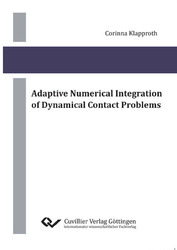| Areas | |
|---|---|
| Serie de libros (96) |
1378
|
| Nachhaltigkeit |
3
|
| Gesundheitswesen |
1
|
| Letra |
2363
|
| Ciencias Naturales |
5406
|
| Matemática | 229 |
| Informática | 319 |
| Física | 980 |
| Química | 1363 |
| Geociencias | 131 |
| Medicina humana | 243 |
| Estomatología | 10 |
| Veterinaria | 108 |
| Farmacia | 147 |
| Biología | 835 |
| Bioquímica, biología molecular, tecnología genética | 121 |
| Biofísica | 25 |
| Nutrición | 45 |
| Agricultura | 1004 |
| Silvicultura | 201 |
| Horticultura | 20 |
| Ecología y conservación de la tierra | 148 |
| Ciencias Ingeniería |
1791
|
| General |
98
|
|
Leitlinien Unfallchirurgie
5. Auflage bestellen |
|
Erweiterte Suche
Adaptive Numerical Integration of Dynamical Contact Problems (Tienda española)
Corinna Klapproth (Autor)Previo
Indice, Datei (49 KB)
Lectura de prueba, Datei (92 KB)
The present thesis deals with the efficient adaptive numerical integration of dynamical contact problems. This is the core problem in the fast and robust simulation of stresses arising in a real patient’s knee joint for different kinds of loading situations. The topic is of high interest in the field of computer-assisted therapy planning, which aims at the generation of a ”virtual patient“. This tool allows the design of effective treatment options and precise surgery strategies within a clinical environment. Potential tasks of patient-specific techniques in orthopedics are osteotomic interventions and the construction and selection of implants or fixation devices.
For realistic predictions of therapeutical manipulations, numerical simulation and optimization are applied on a detailed three-dimensional geometry of the individual patient’s knee (obtained from anatomical CT or MRT image data). In view of a reasonable clinical application, the necessary computations have to be performed on
local workstations in clinics within short time frames. Moreover, the solutions have to be resilient enough to serve as a basis for responsible medical decisions. With regard to these conditions, highest level requirements have to be set on the efficiency and accuracy of the applied numerical techniques.
The appropriate approach to cope with this mathematical challenge is the construction of an adaptive numerical integrator for the dynamical contact problem.
For this purpose, dynamical contact problems have to be analyzed precisely from both the analytical and the numerical point of view.
| ISBN-10 (Impresion) | 3869557699 |
| ISBN-13 (Impresion) | 9783869557694 |
| ISBN-13 (E-Book) | 9783736937697 |
| Idioma | Inglés |
| Numero de paginas | 187 |
| Edicion | 1 Aufl. |
| Volumen | 0 |
| Lugar de publicacion | Göttingen |
| Lugar de la disertacion | Berlin |
| Fecha de publicacion | 26.06.2011 |
| Clasificacion simple | Tesis doctoral |
| Area |
Matemática
|








